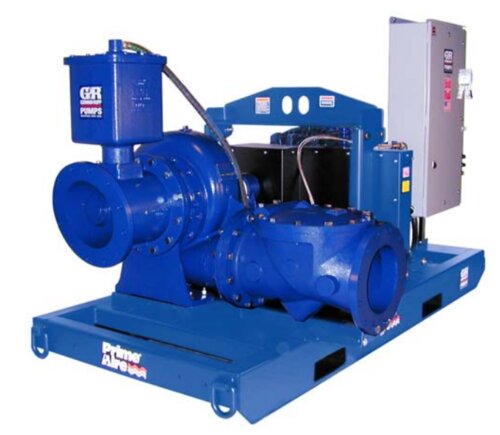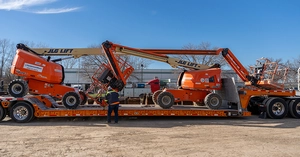The small essentials on your jobsite can be very easy to overlook, especially if they’re a device you use every day. Such a well-used piece of equipment shouldn’t be overlooked. In reality, there are many different kinds of pumps, pipes and lights available. Perhaps the pump or light you’re using is not the best fit for your job. Let us help! Here's a rundown on everything you need to know about the world of pumps, pipes and lights.
What Type of Pump Should I Use?
If you have problems with flooding, oil or gasoline leakage, waste draining or debris cleanup, a pump is the obvious solution. Pumps use a variety of different mechanics to achieve the movement or removal of fluid. What kind of pump you need is entirely dependent on what you are handling and where. Most pumps are labeled by the type of debris they are supposed to remove.
Centrifugal Pumps
Both high-power and easily-portable, centrifugal pumps are a solid choice for pumping fluids. In order to create pressure, a centrifugal pump is equipped with at least one impeller. Unlike a propeller, which uses fan blades to push air away, an impeller uses the same concept to draw air and fluid in, increasing velocity and pressure as it runs. Some pumps are multistage centrifugal pumps that have multiple impellers working in tandem. Because of the constant rotation of the impeller, viscous fluids can cause the pump’s motor to overheat and damage the entire machine. Luckily, pumps are normally labeled for the kind of fluid they’re intended for, such as trash pumps or dewatering pumps.
Diaphragm Pumps
Also called membrane pumps or positive displacement pumps, these pumps use a fundamentally different system than centrifugal pumps. As the name suggests, diaphragm pumps move fluid through a hermetically-sealed membrane. Typically, one side will be filled with hydraulic fluid or air. The diaphragm will flex, displacing the pressure in the pump and drawing in fluid. Then, when it relaxes, the fluid is pushed farther away. Some electrical diaphragm pumps might use the force of a motor to contract the membrane instead of hydraulic fluid, but the end result is the same. Pumps like this are equipped for all kinds of fluids, so they are extremely versatile. However, they are susceptible to pressurizing fluid into gas, which inevitably causes leaks in the diaphragm.
Submersible Pumps
Submersible pumps use the same mechanics of a centrifugal pump, with impellers acting as the source of velocity. Unsurprisingly, they are also referred to as vertical centrifugal pumps. Unlike centrifugal pumps, a submersible pump is dropped into the fluid it is supposed to remove. Submerging the pump prevents the vaporization of the fluid in the pump — preventing air leaks or damage to the machine. Submersible pumps come in virtually any size, so you can use them for sewers and wells, and even pools and ponds. Their versatility means they are in very high demand.
What Types of Pipes and Hoses Should I Use?
No matter how strong your pump is, nothing is going anywhere without the correct pipes and hoses. Although most pipes are labeled by diameter and length, there are still other noticeable differences between each kind of hose.
Suction Hoses
These rigid pipes are commonly made of hard plastic such as polyurethane or polyvinyl chloride. They are unique because they utilize negative pressure to effectively move sewage, water or solid waste. The pressure in the tube is kept below the overall pressure of the environment, causing the hose to suck in the waste and force it further down.
Pressure Hoses
Similar to suction hoses, a pressure hose is typically made of or reinforced with hard plastic. Unlike other hoses, however, pressure hoses use positive pressure to get the job done. The pressure inside the hose is greater than the pressure outside. Although this creates more force than using negative pressure, it also makes the pipe more likely to experience abrasions or leaks. This is especially true if the fluid being moved is highly viscous or contains solids.
Discharge Hoses
If you own a pool or a pond, you likely already have some kind of discharge hose. Unlike other kinds of fluid movement solutions, these are made of rubber or soft plastic, allowing them to be collapsible when empty. This makes storage and transportation considerably easier. However, they are much more likely to be damaged by abrasion, so they are only suited for moving water and waste with mild chemicals.
What Construction Lights Are Best for My Project?
No jobsite is complete without proper lighting. Whether you’re working in a dark, enclosed space, or you plan on working after the sun has set, proper lighting keeps the jobsite running smoothly. Of course, the type of lighting you need depends entirely on your jobsite, but there are plenty of options available.
Light Towers
Depending on its size, a light tower consists of several lights mounted to a moveable arm and connected to a generator. Usually, these light fixtures will come with a hitch and wheels – making them easy to move across jobsites. Towers are extremely versatile since they’re high-power, portable and adjustable. However, their lights can be blinding – it’s important they’re not used near roadways or where vehicles regularly pass. Tower lighting is best used to illuminate small areas of the jobsite.
Balloon Lights
As the name suggests, balloon lights are named because of their balloon-like shape. All lighting balloons have one giant light fixture, which can come in virtually any shape. However, most lights are either a sphere or a cube. They can be suspended through a moveable arm, rope suspension or a simple pole. Unlike other light fixtures, they produce significantly less glare. Because of this, they are often found on roadside jobsites and, interestingly enough, film sets.
Roadway Lights
Sometimes temporary lighting fixtures aren’t enough. When you need a more permanent solution, it may be time to turn to roadway lighting. Just like the lights you see on the side of the street, roadway lighting consists of a series of lights affixed to poles and connected through hard electrical wiring. Typically, you need to hire a licensed electrician to install these. They are more expensive and complicated to install, but they will provide light for much longer than other lighting solutions.
How to Choose Fluid and Lighting Solutions for Your Jobsite
What you should buy or rent boils down to what your needs are. Consider the circumstances of your jobsite and your specific needs when deciding on a pump, pipe or light. Find an EquipmentShare location near you where our team members can help you with fluid solutions, lighting solutions and just about anything for your jobsite.

.svg)
.svg)













